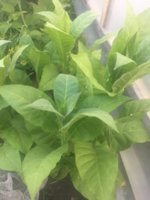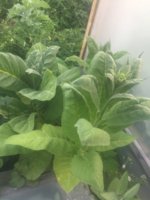ray_koots89
Member
First time growing and ran into this situation with the leaves curling downwards. I searched the ftt site but wasn't able to find anything, so I hope this post can help someone who's facing a similar issue.
From what I've seen and read online this is the primary sign of calcium deficiency in field plants, which is mainly caused by the depletion of calcium around the roots due to their lack of growth relative to the leaves and shoot, apparently not uncommon after a heatwave.
These are Virginia bright leaf plants growing in 3 gallon pots. Half are growing in promix vegetable potting mix, the other half are growing in a mix of peat moss, top soil, and sheep manure. I used a standard dose of the shake and feed miracle grow tomato fertilizer back in late May when they were last repotted. I use faucet water, it has high alkalinity (~170 mg/L calcium carbonate) and a pH of 8 or so, and I think is the cause of what's happening with the leaves.
I'm wondering if these are worth curing or not. The last photo is of one of the slack sea samsun plants, which so far hasn't shown symptoms like the bright leafs.
Thanks all, appreciate any help and insights into this,




From what I've seen and read online this is the primary sign of calcium deficiency in field plants, which is mainly caused by the depletion of calcium around the roots due to their lack of growth relative to the leaves and shoot, apparently not uncommon after a heatwave.
These are Virginia bright leaf plants growing in 3 gallon pots. Half are growing in promix vegetable potting mix, the other half are growing in a mix of peat moss, top soil, and sheep manure. I used a standard dose of the shake and feed miracle grow tomato fertilizer back in late May when they were last repotted. I use faucet water, it has high alkalinity (~170 mg/L calcium carbonate) and a pH of 8 or so, and I think is the cause of what's happening with the leaves.
I'm wondering if these are worth curing or not. The last photo is of one of the slack sea samsun plants, which so far hasn't shown symptoms like the bright leafs.
Thanks all, appreciate any help and insights into this,










